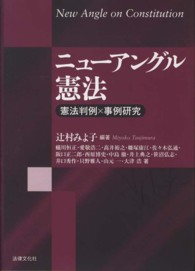Full Description
In Alive in the Sound, Ronald Radano proposes a new understanding of US Black music by focusing on the key matter of value, manifested musically in its seemingly embodied qualities - spirit, soul, and groove. While acknowledging these qualities are always embedded in Black music, Radano shows they developed not simply from performance but from musicians' status as laborers inhabiting an enduring racial-economic contradiction: Black music originated publicly as an exchangeable property owned by people whose subhuman status granted them - as "natural" musicians - indelible properties of sound. As a contradiction of the rules of ownership, where enslaved property was forbidden the right to own, modern Black music emerges after emancipation as a primary possession, moving dialectically into commercial markets and counterhistorically back into Black worlds. Slavery's seminal contests of ownership underlie modern musical sensations of aliveness, which become the chief measure of value in popular music. By reconceiving US Black music history as a history of value, Radano rethinks the music's place in US and global culture.
Contents
Preface ix
Acknowledgments xv
Introduction. Black Labor, Value, and the Anomalies of Enlivened Sound 1
First Metamorphosis: Property's Properties of Reconstructive Possibility
1. Slave Labor and the Emergence of a Peculiar Music 41
Second Metamorphosis: Free Labor and the Racial-Economic Transaction of Animated Form
2. Scabrous Sounds of a Vagrant Proletariat 81
3. Minstrelsy's Incredible Corporealities 118
Third Metamorphosis: Contests of Ownership in Early National Markets
4. Ragtime's Double-Time Accumulation 159
5. New Coalescences of Spectacular Form: Stride Piano and Ragtime Piano Rolls 189
6. Commodity Circuits and the Making of a Jazz Counterhistory 223
Fourth Metamorphosis: Racialized Embodiments of Hypercapitalized Pop
7. Swing: Black Music's New Modern Becoming 283
8. Living Forms, Imagined Truths: Aesthetic Breakthroughs in Jazz at Midcentury 331
9. Apotheosis of a New Black Music 365
Afterword: Modernity's Ghosts 424
Notes 429
Bibliography 493
Index








